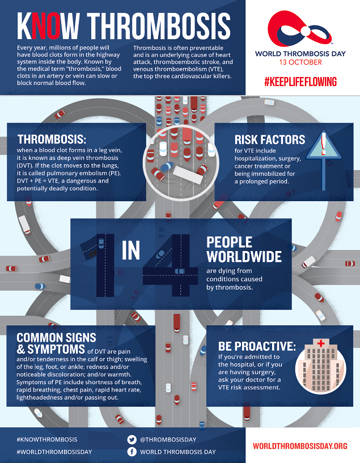Focusing on Global Education of Risk Factors, Signs, and Symptoms of Thrombosis
The deep vein thrombosis (DVT) team of the Stony Brook Vascular Center supports the World Thrombosis Day campaign to raise awareness about the serious condition of thrombosis.
The Stony Brook Vascular Center joins more than 1,300 organizations from 98 countries in a united effort to raise awareness of thrombosis — the underlying cause of the world's top three cardiovascular killers: heart attack, stroke, and venous thromboembolism (VTE).
VTE is a condition in which blood clots form most often in the deep veins of the leg and can travel in the circulation and lodge in the lungs (known as pulmonary embolism, PE).
VTE is a life-threatening but often preventable condition that affects millions of people worldwide.
Now in its fifth year, World Thrombosis Day's focus is Know Thrombosis, which encourages the general public, healthcare professionals, and key decision-makers to know the risk factors, signs, and symptoms of the condition.
Hospitalization is a top risk factor for VTE, with up to 60% of all VTEs occurring during or after hospitalization. VTE is the leading preventable cause of hospital death.
Our multi-specialty DVT team, led by Antonios P. Gasparis, MD, provides a hospital-wide program for patient assessment and DVT prophylaxis.
One in four people worldwide are dying from conditions caused by thrombosis, but many are unaware of the risks. That's why raising awareness of VTE and its prevention and treatment is crucial to ultimately saving lives.
Risk factors for thrombosis in veins may include:
- A family history and/or personal history of DVT
- Hormone therapy or birth control pills
- Pregnancy
- Injury to a vein, such as from surgery, a broken bone, or other trauma
- Lack of movement, such as after surgery or on a long trip
- Inherited blood-clotting disorders
- A central venous catheter
- Older age
- Smoking
- Being overweight or obese
- Some health conditions, such as cancer, heart disease, lung disease, or Crohn's disease
Risk factors for thrombosis in arteries may include:
- Smoking
- Diabetes
- High blood pressure
- High cholesterol
- Lack of activity and obesity
- Poor diet
- Family history of arterial thrombosis
- Lack of movement, such as after surgery or on a long trip
- Older age
| Observed on October 13, World Thrombosis Day is an annual event led by the International Society on Thrombosis and Haemostasis and carried out by hundreds of organizations holding more than 9,000 events worldwide. Healthcare professionals should see this VTE Infographic. |


